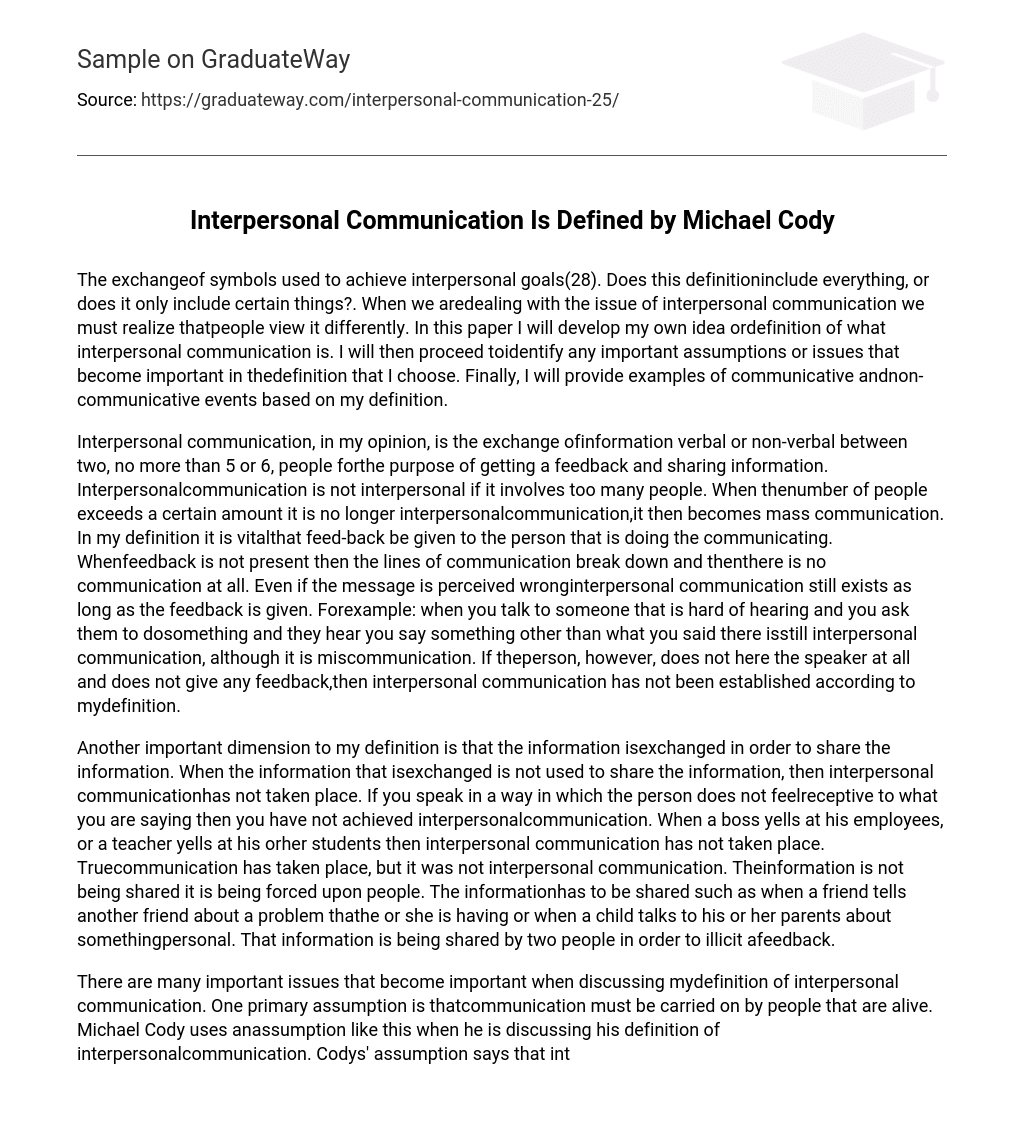The exchangeof symbols used to achieve interpersonal goals(28). Does this definitioninclude everything, or does it only include certain things?. When we aredealing with the issue of interpersonal communication we must realize thatpeople view it differently. In this paper I will develop my own idea ordefinition of what interpersonal communication is. I will then proceed toidentify any important assumptions or issues that become important in thedefinition that I choose. Finally, I will provide examples of communicative andnon-communicative events based on my definition.
Interpersonal communication, in my opinion, is the exchange ofinformation verbal or non-verbal between two, no more than 5 or 6, people forthe purpose of getting a feedback and sharing information. Interpersonalcommunication is not interpersonal if it involves too many people. When thenumber of people exceeds a certain amount it is no longer interpersonalcommunication,it then becomes mass communication. In my definition it is vitalthat feed-back be given to the person that is doing the communicating. Whenfeedback is not present then the lines of communication break down and thenthere is no communication at all. Even if the message is perceived wronginterpersonal communication still exists as long as the feedback is given.
Forexample: when you talk to someone that is hard of hearing and you ask them to dosomething and they hear you say something other than what you said there isstill interpersonal communication, although it is miscommunication. If theperson, however, does not here the speaker at all and does not give any feedback,then interpersonal communication has not been established according to mydefinition.
Another important dimension to my definition is that the information isexchanged in order to share the information. When the information that isexchanged is not used to share the information, then interpersonal communicationhas not taken place. If you speak in a way in which the person does not feelreceptive to what you are saying then you have not achieved interpersonalcommunication. When a boss yells at his employees, or a teacher yells at his orher students then interpersonal communication has not taken place. Truecommunication has taken place, but it was not interpersonal communication. Theinformation is not being shared it is being forced upon people. The informationhas to be shared such as when a friend tells another friend about a problem thathe or she is having or when a child talks to his or her parents about somethingpersonal. That information is being shared by two people in order to illicit afeedback.
There are many important issues that become important when discussing mydefinition of interpersonal communication. One primary assumption is thatcommunication must be carried on by people that are alive. Michael Cody uses anassumption like this when he is discussing his definition of interpersonalcommunication. Codys’ assumption says that interpersonal communication occursbetween people who are in a state of being. His state of being is differentform mine in that I mainly imply that the person must be alive in order toestablish interpersonal communication. In Cody’ assumption his state of beingis three pronged including, 1) people change, 2) people are searching formeaning for development and 3) it implies that communication can never bereplicated (Cody 30). When Cody talks about “being ” he is going into moredetail than I would. As stated earlier my state of being means just being alive.
Another important issue that needs to be brought up when discussing mydefinition of interpersonal communication is the issue of the number of people.
When dealing with the issue of interpersonal communication the amount of peoplebeing communicated with is of utmost importance. Can a preacher haveinterpersonal communication with his congregation on Sunday morning?. Accordingto my definition he cannot. Interpersonal communication must be done when thereis a certain amount of people. You cannot have one person and haveinterpersonal communication, likewise, you cannot have a hundred people and haveinterpersonal communication either. Interpersonal communication must be donewhen at least two people are present. In order for the communication to stayeffective you cannot have more than six people. The reason for the limitationis that when too many people get involved it becomes harder to bring forth themessage that you want to send. As I stated earlier if the message is not sentand shared then interpersonal communication has not taken place.
Finally, I would like to discuss some examples of communicative and non-communicative events based on the definition that I have given. An example of acommunicative event that would use my definition would be as follows: When twopeople are talking they are speaking to each other in order to changeinformation. For example: When you walk the street and you see someone youknow you speak and you ask ” how was your day”. The point when you asked howthe persons day was you initiated the process of interpersonal communication.
The person will respond, and the information that the person shares with youcompletes the process of interpersonal communication.
An example of non- verbal communication using my definition is somewhatmore difficult. When you are sitting at restaurant and you a start playing foottag with your date you are sending a non-verbal form of interpersonalcommunication. The first contact of the foot is the initiation of thecommunication. When the person responds, favorably or unfavorably, non-verbalinterpersonal communication has taken place.
In conclusion I would like to say that developing a definition forinterpersonal communication is no easy task. Because interpersonalcommunication is such a vague topic it makes it that more difficult. With mucheffort and practice we can develop a universal definition for interpersonalcommunication. Interpersonal communication, in my opinion, is the exchange ofinformation verbal or non-verbal between two, no more than 5 or 6, people forthe purpose of getting a feedback and sharing information. I have explained myreasons for choosing this definition and I have also given information andexample that will support it. My definition is by no means exhaustive, but Ithink it is a start to developing a universally excepted definition for the terminterpersonal communication.





